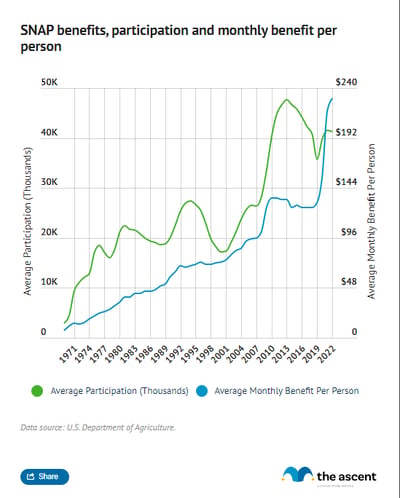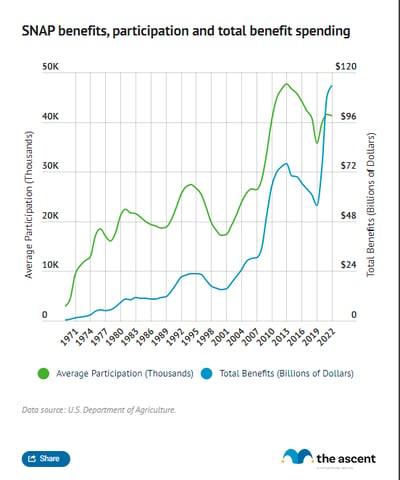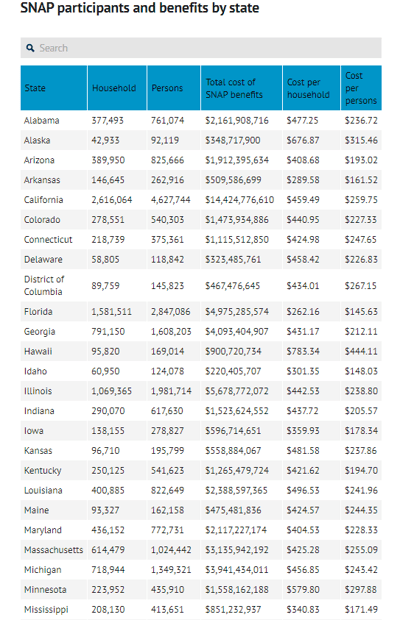SNAP Statistics and Eligibility Changes for 2023
The Supplemental Nutrition Assistance Program helps over 42 million low-income households afford groceries each month -- but big changes have recently impacted the program formerly known as food stamps.
As of March 2023, SNAP emergency allotments have ended, resulting in a reduction of at least $95 in SNAP benefits per month for qualifying households. Eighteen states had previously ended emergency allotments for SNAP participants.
SNAP benefits have since reverted to pre-pandemic amounts for all participating households. The end of emergency allotments could create challenges for many households due to recent food price inflation, according to the U.S. Department of Agriculture.
The Motley Fool Ascent has compiled the latest SNAP benefits news and data throughout this report.
Key findings
- SNAP emergency allotments, which provided an additional $95 in SNAP benefits per household per month, ended as of March 2023.
- Over 42 million households received SNAP benefits in FY 2022 (October 2021 through September 2022).
- The average monthly SNAP benefit per household for that period was $230, up about $100 from the amount given throughout the 2010s. A total of $114 billion in SNAP benefits was distributed in FY 2022.
- Prior to FY 2021, total SNAP benefits distributed had not exceeded $100 billion.
What are SNAP benefits?
SNAP provides monthly electronic benefits transfer (EBT) cards to qualifying households. These function like prepaid debit cards and can be used to make food purchases at eligible, licensed retailers.
The amount of SNAP benefits provided is calculated based on the size of the household, the household's net income, and the maximum SNAP benefit that can be provided in the fiscal year. The maximum monthly SNAP benefit is calculated based on the cost of a "nutritionally adequate low-cost diet," as laid out in USDA Thrifty Food Plan.
Who is eligible for SNAP benefits?
SNAP eligibility is determined on a household basis. Two methodologies can be used to determine SNAP eligibility: traditional or categorical.
There are work requirements to qualify for SNAP benefits, such as registering for work with a state employment office, accepting a job if offered one, fulfilling job search or training requirements as required by state SNAP agencies, and others. These requirements do not apply to older adults and people with disabilities in all states.
Job search and training requirements differ by state.
College students and non-citizens are generally not eligible for SNAP benefits.
SNAP benefits: Traditional eligibility
Traditional eligibility is based on household gross income, net income, and assets. Gross household monthly income cannot be over 130% of the federal poverty level.
Household net monthly income cannot be over 100% of the federal poverty level. The household asset limit for FY 2023 is $2,750. Exceptions apply for households with disabled or elderly members.
SNAP benefits: Categorical eligibility
Categorical eligibility is based on whether an applicant is a participant in Security Income (SSI), Temporary Assistance for Needy Families (TANF), or General Assistance (GA). If an applicant is a participant in any of those means-tested programs, they are automatically eligible for SNAP benefits.
SNAP benefits statistics
Over 42 million households received SNAP benefits in FY 2022 (October 2021 through September 2022). The average monthly SNAP benefit per household for that period was $230, up about $100 from the amount given throughout the 2010s. A total of $114 billion in SNAP benefits was distributed in FY 2022.

Prior to FY 2021, total SNAP benefits distributed had not exceeded $100 billion. Before 2009, the cost of SNAP benefits had not exceeded $50 billion.
The COVID-19 pandemic did not result in a significant spike in households participating in SNAP, but the supplemental emergency allotments authorized by Congress in response to the pandemic led to a sizeable increase in average benefit per household and total cost of SNAP benefits in 2021 and 2022.

According to the Urban Institute, emergency allotments helped 4.2 million Americans stay above the poverty line in the fourth quarter of 2021. Emergency allotments reduced poverty by 10% and reduced child poverty by 14%.
What SNAP benefits will change in 2023?
There are two important changes to SNAP benefits in 2023: the expiration of SNAP benefit emergency allotments in March and the annual cost of living adjustment scheduled for October.
Expiration of pandemic-era SNAP benefit emergency allotments
As of March 2023, emergency allotments for SNAP benefits will no longer be issued. SNAP benefits will be distributed at normal amounts.
Emergency allotments, authorized in response to the COVID-19 pandemic, provided an additional $95 in monthly benefits or a value worth up to the maximum benefit for the household size of the recipient, whichever was greater.
The following 18 states had previously ended supplemental SNAP benefit emergency allotments: Alaska, Arizona, Arkansas, Florida, Georgia, Idaho, Indiana, Iowa, Kentucky, Mississippi, Missouri, Montana, Nebraska, North Dakota, South Carolina, South Dakota, Tennessee, and Wyoming.
Cost of living adjustments, Social Security, and SNAP benefits
On Oct. 1, the start of the fiscal year, SNAP maximum benefits, deductions, and income eligibility are adjusted based on the cost of living.
Because the Social Security Administration updates Social Security benefits based on inflation in January each year, some SNAP participants who receive Social Security may have seen their SNAP benefits decrease or be eliminated subsequently based on their new household income. The increase in Social Security benefits is larger than any decrease in SNAP benefits.
SNAP benefits by state
The following table shows the number of households and individuals participating in SNAP per state, along with how much each state spends on SNAP benefits, and cost per household and per person in FY 2022 (October 2021 to September 2022).

States with more residents -- California, New York, Florida, and Texas, for example -- logically have the most households and individuals receiving SNAP benefits and are among the top spenders on SNAP benefits.
However, not all of those states spend the most on SNAP benefits per household or per person.
Hawaii spends the most per household ($783) and per person ($444) on SNAP benefits, followed by Alaska. Those two states spend more because maximum benefits and eligibility requirements are assessed based on local cost of living, which is higher than the continental United States.
Florida is an outlier. The state has the third most households (1.6 million) and individuals (2.8 million) receiving SNAP benefits, while spending the least per household ($262) and second least per individual ($146). This is likely partly due to Florida ending emergency allotments as of August 2021 when the state terminated its emergency health declaration.
SNAP scams
USDA has warned of two types of scams involving SNAP benefits in recent months: A phony text message phishing scam and an EBT card skimming scam.
The phishing scam involves a SNAP participant receiving a fraudulent text message from a scammer claiming the SNAP recipient's EBT card is locked and instructions to call a number for assistance unlocking the card. Scammers will then request personal information from the SNAP benefit recipient they claim is necessary to unlock the card, but in reality can be used for identity theft and other types of fraud.
The EBT card skimming scam occurs when crooks modify a retailer's point-of-sale device to copy EBT card information upon swiping. With that information, scammers can siphon funds from SNAP participants.
Congress recently passed legislation that requires states to reimburse SNAP beneficiaries for up to two months of benefits twice a year. Previously, many states opted not to cover lost funds.
FAQs
SNAP applications and eligibility determinations are done on a state basis. State SNAP offices provide and process applications. A list of state SNAP offices is available via USDA.
SNAP benefits are provided via electronic balance transfer (EBT) cards. EBT cards function like a pre-loaded debit card and only function at authorized stores or vendors for the purchase of authorized food items.
SNAP is distinct from WIC, the Special Supplemental Nutrition Program for Women, Infants and Children. Differences between SNAP and WIC come in two areas: benefits and eligibility.
SNAP provides monthly funds to purchase food via an EBT card. WIC participants also receive a similar card that authorizes the purchase of food approved by the program. WIC cards do not come with funds to spend.
WIC participants also receive nutrition education and support for breastfeeding.
Both WIC and SNAP are meant to help low-income Americans meet nutritional needs; however, they come with different eligibility requirements.
SNAP eligibility is based on household income while WIC eligibility is based on income and other restricting factors.
WIC participants must be pregnant, postpartum, or breastfeeding, or have dependents under the age of five.
In addition, to be eligible for WIC, participants must have an income below the level set by the relevant state agency -- at least 100% of the poverty line but it can be up to 185% of the poverty line depending on the state.
Finally, a doctor, nurse, or nutritionist must determine that a member of the household seeking WIC benefits is a nutrition risk.
The federal government through the Food and Nutrition Service offers food assistance programs similar to SNAP and WIC.
Those include child nutrition programs like the National School Lunch Program, which provides free or low-cost school lunches for kids.
The Emergency Food Assistance Program also provides low-income Americans with free emergency food assistance usually distributed through food banks.
Sources
- Congressional Research Service (2022). "Supplemental Nutrition Assistance Program (SNAP): A Primer on Eligibility and Benefits."
- Urban Institute (2022). "Effect of the Reevaluated Thrifty Food Plan and Emergency Allotments on Supplemental Nutrition Assistance Program Benefits and Poverty."
- U.S. Department of Agriculture. "Changes to SNAP Benefit Amounts - 2023."
- U.S. Department of Agriculture. "SNAP Data Tables."
- U.S. Department of Agriculture. "Supplemental Nutrition Assistance Program (SNAP) Scam Alerts."
Our Research Expert
We're firm believers in the Golden Rule, which is why editorial opinions are ours alone and have not been previously reviewed, approved, or endorsed by included advertisers. The Ascent, a Motley Fool service, does not cover all offers on the market. The Ascent has a dedicated team of editors and analysts focused on personal finance, and they follow the same set of publishing standards and editorial integrity while maintaining professional separation from the analysts and editors on other Motley Fool brands.